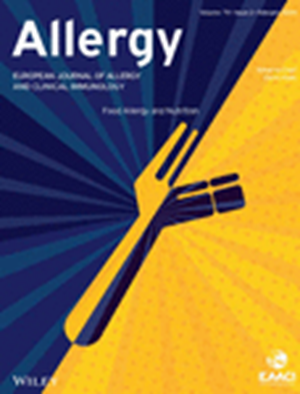SQ屋尘螨舌下免疫治疗片治疗儿童过敏性哮喘:一项随机III期试验
IF 12
1区 医学
Q1 ALLERGY
引用次数: 0
摘要
在儿童中,室内尘螨(HDM)致敏是过敏性哮喘的一个促进因素。HDM过敏原免疫疗法已证明对成人过敏性哮喘的有效性和安全性;然而,在儿童中使用它的证据有限。MT‐11评估了SQ HDM舌下免疫治疗(SLIT)片剂对5-17岁儿童HDM过敏性哮喘的疗效和安全性。方法:该III期随机、双盲、安慰剂对照试验将533名近期有哮喘发作史的儿童随机分组,尽管接受吸入皮质类固醇和/或长效β受体激动剂治疗,但每天接受SQ HDM SLIT片或安慰剂治疗24-30个月。主要终点是临床相关哮喘发作的年化率。不良事件(ae)在整个试验中都有报道。结果临床相关哮喘加重的年化发生率为0.89 (95% CI: 0.60, 1.31),有利于SQ HDM‐SLIT片;其优于安慰剂的优势尚未得到证实。大多数与治疗相关的ae (TRAEs)的严重程度为轻度或中度,少数受试者因TRAEs而停药(2%)。最常见的TRAEs是局部应用部位反应(口腔瘙痒、喉咙刺激、耳朵瘙痒和上腹部疼痛)。SQ - HDM SLIT片组没有哮喘相关事件的发生率增加,也没有过敏反应或肾上腺素的使用。结论受2019冠状病毒病大流行影响,哮喘加重率远低于预期,导致主要终点未达到。SQ HDM SLIT片在HDM过敏性哮喘控制不充分的儿童人群中耐受性良好。trials RegistrationClinicaltrials.gov识别码:NCT03654976;草案编号:2016‐004363‐39本文章由计算机程序翻译,如有差异,请以英文原文为准。
SQ House Dust Mite Sublingual Immunotherapy Tablet in Children With Allergic Asthma: A Randomised Phase III Trial
BackgroundIn children, house dust mite (HDM) sensitisation is a contributing factor for developing allergic asthma. HDM allergen immunotherapy has demonstrated efficacy and safety in adults with allergic asthma; however, evidence for its use in children is limited. MT‐11 evaluated the efficacy and safety of the SQ HDM sublingual immunotherapy (SLIT) tablet in children (5–17 years) with HDM allergic asthma.MethodsThis phase III, randomised, double‐blind, placebo‐controlled trial randomised 533 children with a recent history of asthma exacerbations, despite treatment with inhaled corticosteroids and/or long‐acting beta‐agonists, to daily treatment with SQ HDM SLIT‐tablet or placebo for 24–30 months. The primary endpoint was the annualised rate of clinically relevant asthma exacerbations. Adverse events (AEs) were reported throughout the trial.ResultsThe rate ratio for the annualised rate of clinically relevant asthma exacerbations was 0.89 (95% CI: 0.60, 1.31), in favour of the SQ HDM‐SLIT tablet; superiority over placebo was not established. Most treatment‐related AEs (TRAEs) were of mild or moderate severity, and few subjects discontinued due to TRAEs (< 2%). The most common TRAEs were local application site reactions (oral pruritus, throat irritation, ear pruritus, and upper abdominal pain). There was no increased incidence of asthma‐related events, and no anaphylaxis or adrenaline use in the SQ HDM SLIT‐tablet group.ConclusionAs a result of the coronavirus disease 2019 pandemic, asthma exacerbation rates were much lower than expected, contributing to the primary endpoint not being met. The SQ HDM SLIT‐tablet was well tolerated in a paediatric population with inadequately controlled HDM allergic asthma.Trial RegistrationClinicaltrials.gov identifier: NCT03654976; EudraCT number: 2016‐004363‐39
求助全文
通过发布文献求助,成功后即可免费获取论文全文。
去求助
来源期刊

Allergy
医学-过敏
CiteScore
26.10
自引率
9.70%
发文量
393
审稿时长
2 months
期刊介绍:
Allergy is an international and multidisciplinary journal that aims to advance, impact, and communicate all aspects of the discipline of Allergy/Immunology. It publishes original articles, reviews, position papers, guidelines, editorials, news and commentaries, letters to the editors, and correspondences. The journal accepts articles based on their scientific merit and quality.
Allergy seeks to maintain contact between basic and clinical Allergy/Immunology and encourages contributions from contributors and readers from all countries. In addition to its publication, Allergy also provides abstracting and indexing information. Some of the databases that include Allergy abstracts are Abstracts on Hygiene & Communicable Disease, Academic Search Alumni Edition, AgBiotech News & Information, AGRICOLA Database, Biological Abstracts, PubMed Dietary Supplement Subset, and Global Health, among others.
 求助内容:
求助内容: 应助结果提醒方式:
应助结果提醒方式:


